Adorning the walls of Kanji Nishi's three-roomed apartment are a dozen framed photos. None features his children, Shota and Chisato, who are sitting cross-legged on the floor shunning smartphones for origami artistry. Instead, Nishi is seen posing alongside a different kind of pride and joy.
One, taken in 2002, shows him with a 246-kilogram Pacific bluefin tuna, while in another, dated 2006, he's standing next to a glistening 261-kilogram giant. All but one bluefin pictured in the commemorative snaps weighed in at over 200 kilograms, each hooked and hauled aboard his boat by Nishi himself via a single pole and line, and pictured for posterity suspended from a crane on the pebble-dashed concrete of Ashibe Port on Iki Island, Nagasaki Prefecture.
At day-break that morning we had ventured out on Nishi's 5-ton boat, the Myojo Maru, in search of more bluefin, which is known by most Japanese as kuro-maguro, or to those that trade its prized flesh, "black diamond." After five hours battling stomach-churning kahunas, we returned with a solitary tuna weighing in at 35 kilograms — still a notable size at the local market that day.
Six years on and Nishi has all but packed in ippon-zuri (pole and line) tuna fishing in favor of work aboard long-line vessels that fish in the waters off Ashibe for kue, or grouper kelp.
"There were simply no tuna to catch," Nishi says. "The last big tuna I caught was nine years ago — you rarely see that size anymore. It's not so long ago that you could bring home 20 or 30 tuna in a day. Now you're lucky to land one."
Nishi's plight is reflected in the catch data from Iki's main port, Katsumoto. In 2005, 358 tons of bluefin were unloaded there by the island's 400 ippon-zuri fishermen. In 2014, they brought home just 23 tons.
"There's no work there anymore," says Nishi, who was among those who fruitlessly scoured the depths of the once-rich fishing grounds of Shichiri-ga-sone in 2014. "Some of the younger fishermen have already quit."
It is a trend that is being witnessed throughout Japan. More than 230 long-line boats operating off the coast of the Kii Peninsula in Wakayama Prefecture landed 64 tons of bluefin in 2014, compared with 439 tons a decade earlier, according to local fisheries official Tatsumi Naka. Overall tuna catch, meanwhile, was up around 14 percent over the same period, though still down 30 percent compared with 1994.
"While data suggests a glimmer of hope for tuna overall, that certainly can't be said for bluefin," Naka says. "They get snapped up on the Sea of Japan before they are given the chance to mature fully. If fishermen there could wait a little longer, I think we'd all be able to catch bigger bluefin once more."
According to some reports, overexploitation of Pacific bluefin tuna has reduced its population by as much as a third over the past two decades. More critical, experts say, is the plunge in spawning stocks, with the International Union for Conservation of Nature reporting that current levels are estimated to be just 4 percent of precommercial fishing levels calculated through simulations. Indeed, the IUCN in late 2014 moved Pacific bluefin into the "vulnerable" category on its "red list," which is reserved for species facing "high risk of extinction."
Toshio Katsukawa, a fisheries expert at Tokyo University of Marine Science and Technology, is among an increasing number who believe the fish, which is highly prized in the sushi and sashimi markets of Japan and some other Asian countries, may well be listed on the Convention on International Trade in Endangered Species of Wild Fauna and Flora when members meet in Johannesburg later this year.
"Overfishing has led to a massive depletion of stocks and, if the current situation continues, the Pacific bluefin could be facing extinction in the very near future," Katsukawa says.
In his Tokyo office, Katsukawa opens color-coded graphs and tables on his iPad to explain just how critical the situation has become. Japan, he explains, has two spawning grounds — one in the Sea of Japan, the other off Okinawa, where the fish that gather there to breed have one crucial difference.
The former, he says, are young parents that spawn about five times, but, after attaining a body length of about 2 meters, migrate southwest to the breeding grounds of Okinawa, where spawners are older and larger. "However, it is clear through the data available that this pattern changed dramatically after 2004," he says.
By examining distribution maps for both grounds, Katsukawa concluded that new recruits were no longer arriving at the westernmost spawning grounds. Only the older adults remained.
That change coincided with a notable shift in fishing practices by some of the 66 purse seine vessels operating in Japan's waters, which relocated away from the Pacific, where bluefin were becoming increasingly scarce, and over to the Sea of Japan in the summer months. Other purse seiners that had previously netted rapidly depleting stocks of mackerel, herring and sardines also joined them.
The target of this fleet was the spawning grounds that stretch from off Ishikawa's Noto Peninsula and spread westward as far as the Oki Islands in Shimane and beyond. Even when stocks are seriously depleted, tuna make their way there in the spawning season in vast schools, their movements detected by the purse seiner's cutting-edge sonar systems, experts say.
"It's a specific place with favorable spawning conditions that is known to the purse seiners," says Isao Sakaguchi, a professor of environmental governance at Gakushuin University and an expert in the science of bluefin tuna. "Purse seiners go to those areas at the exact moment of spawning, with their massive nets at the ready. It's easy."
Those that survive migrate toward Nagasaki, known as an important "nursery" for bluefin juveniles, which also swim up from Okinawa, Sakaguchi says. There purse seiners, along with trollers and, to a lesser degree, coastal nets, strike again — a practice that started around 30 years ago but intensified in the mid-1990s, he adds.
"In fact, around 96 percent of bluefin caught in Japan are taken from the water before they can reproduce," Sakaguchi says. "If they hadn't done this, then probably the stocks could have stayed at a healthy level for fishermen to continue catching bluefin in the Pacific."
Japan has shown a reluctance to act, but last year it introduced new regulations set by the Western and Central Pacific Fisheries Commission, an international body that monitors most of the western Pacific. Starting last January, catches of bluefin weighing less than 30 kilograms were reduced to 50 percent of the catch average between 2002 and 2004 — or 4,007 tons. Around half was allocated to purse seiners. It also called for a limit on catches of bluefin weighing more than 30 kilograms to the 2002-04 average, equating to a voluntary quota of 4,882 tons.
However, calls for tighter regulations on fishing in the spawning grounds fell on deaf ears, Katsukawa says.
"These are not regulations, just rhetoric," he says. "They are using expressions like 'cut in half' to give the impression that strict action is being taken, but the catch base period being used represents a time when there was double the amount of tuna."
What's more, the new quota for fish weighing less than 30 kilograms is "pointless," he adds, because it "cannot be reached no matter how hard the fishermen try."
To demonstrate his point, Katsukawa points to official data relating to current regional catch quotas and the actual volume being caught. For the western Kyushu block, which includes Iki Island, a catch quota of 1,269 tons has been set for an 18-month period starting January 2015. As of October, just 159 tons had been reported.
Katsukawa says this is the outcome of plummeting resources in the Pacific, concerns about which he has voiced for more than a decade.
"Those concerns were ignored," he says. "It was only since the bluefin faced extinction that the need for regulations has been acknowledged. It's like idly chatting about what should be done in the case of a fire while the fire is already raging around you."
The stated aim of restrictions set by the Fisheries Agency, which declined requests by The Japan Times for an interview, was to increase spawning stock levels to the "historical" median, or 6.7 percent of unfished stocks, by 2024, a figure three times lower than the 20 percent proposed by the United States.
Masanori Miyahara, who heads the Fisheries Research Agency, told reporters at a Ministry of Agriculture, Forestry and Fisheries briefing last July that domestic fishermen would effectively be forced to reduce their catches to zero if the U.S. proposal was adopted and, "worse still, face the danger of being cornered into artificial fishing bans."
Waseda University researcher Yasuhiro Sanada calls Japan's proposal "woefully inadequate" and highly unlikely to bring about a recovery of the depleted stocks.
"Even though the stocks have been so decimated, I believe the U.S. target of 20 percent is realistic," Sanada says, adding that Japan's high tuna consumption (80 percent of the world's total) and catch share (63 percent of global harvests) means Japan has an obligation to regulate. "Japan says that its target is the historical average from the period 1952 to 2012 and, therefore, more realistic, but tuna fishing was going on well before 1950, when the population would have been significantly bigger."
Indeed, research undertaken by the National Research Institute of Far Seas Fisheries in Shizuoka Prefecture reveals substantial tuna fishing in Japan dating back to the late 19th century. This peaked in the prewar years, with one Association of Agriculture and Forestry Statistics graph, dated 1978, revealing catches of more than 85,000 tons in 1939 alone.
Jamie Gibbon, a senior researcher in the Global Tuna Conservation Group of the Pew Charitable Trusts, agrees with Sanada's assessment, saying that Japan's measures won't result in a "meaningful improvement under the water."
However, he adds, "all tuna management" should now move away from yearly quota setting, which takes up a lot of time through lengthy negotiation and results in quotas and catch limits "that don't reflect the best available science."
Gibbon believes the time is ripe for bluefin to move toward longer-term management programs called "harvest strategies," where a predefined set of rules that are preagreed by all members of the Western and Central Pacific Fisheries Commission allow scientific information to be fed into those rules to determine a catch limit.
"There were attempts during the 2015 WCPFC Northern Committee meeting (in Sapporo) to start this process ... with the U.S. suggesting a 20 percent recovery goal over 10 to 15 years," Gibbon says. "We were really disappointed that even before the meeting started Miyahara indicated that Japan was not willing to even enter the discussion about these long-term management measures."
As there have yet to be any new stock assessments made, it is impossible to say exactly what it would take for Japan to reach that 20 percent, Gibbon adds, making Miyahara's claim that Japan would have to cease catches to achieve such a target all the more baffling. Indeed, Miyahara himself has stated that over the years, marine environmental conditions have changed to such a degree that previously conducted simulations and surveys are in dire need of updates.
Experts such as Sakaguchi say data-based logic is often in short supply when it comes to claims by Japan's fisheries bodies. The Fisheries Agency claims that there is no scientific evidence connecting purse seine fishing of spawning stocks with a detrimental impact on recruitment, or new fish entering the population, adding that low recruit numbers are due to unfavorable environmental factors such as rising ocean temperatures.
Sakaguchi says he has examined all relevant records and scientific papers from the International Scientific Committee, but "couldn't find a single statement" to support such views.
"The ISC has never taken such a stance (that fishing of spawners doesn't damage bluefin stocks) because it has never specifically analyzed that impact," he says.
Sakaguchi says that to perform the required multiple factor regressive analysis to show the stipulated relationship "is easy" and was, in fact, undertaken by a group of Japanese researchers in the 1990s — the results of which are in direct conflict with the Fisheries Agency's claims.
"Nonetheless, the Fisheries Agency made its claim without ever undertaking such basic analysis," says Sakaguchi, who also claims to have uncovered examples where the Fisheries Agency has deliberately "disguised" data presented in the Diet that sought to downplay the impact of purse seine catches of bluefin spawners. "From a scientific perspective, that is beyond absurd. All the researchers at the Fisheries Research Agency know this, but cannot say so for fear of punishment."
Pew's Gibbon says the most worrisome element of the Fisheries Agency's argument is that it means they are effectively absolving themselves of the need to manage the capturing of adults. "That's risky business for a fishery that's only at 4 percent of its historical high," he says.
The Fisheries Agency's regulation phobia is deep-rooted, dating back to a time when fishermen freely exploited marine resources far and wide, according to Tokyo University of Marine Science and Technology's Katsukawa.
From the 1970s, various regional and international mandates curtailed such forays, and Japan set out on a mission to object to any kind of regulations "in order to protect its vested interests," Katsukawa says.
"It has continued to object to protect fisheries' short-term profits," he says. "This is why Japanese fisheries-related entities and the Fisheries Agency's basic mentality is to object to regulations on bluefin and view all environmental activists as the bad guys."
Experts say the lack of meaningful change is also down to deep-rooted ties between Fisheries Agency officials and the three main companies and their subsidiaries operating the majority of the bluefin-targeting purse seine liners.
"One reason the government won't accept meaningful proposals for change is that Japanese bureaucrats never admit failure," Waseda's Sanada says. "Another reason is their ties to the purse seine industry — so-called amakudari (the practice of providing retired ministry officials with lucrative jobs in private firms and quasi-government entities)."
Sanada says a sea change in the past few years is an increase in voices calling for a change in bluefin policy and a move toward sustainable fisheries. Organizations such as Seafood Legacy, which started operations last year, are working with retailers to stock sustainably caught bluefin and other produce, while Tsukiji tuna trader Yoshikatsu Ikuta has developed a labeling system whereby sustainably caught tuna bares the label of his organization, Seafood Smart.
"I believe that changing the Japanese market to a sustainable one will directly contribute to saving the oceans," says Wakao Hanaoka, who quit his job as an Oceans campaigner at Greenpeace to start up Seafood Legacy, which played a hand in supermarket chain AEON commencing its "Seafood Baton" sustainable catch corner last year. "In the West, many retailers stop selling seafood if it becomes endangered and consumers applaud that approach. We need that level of consciousness in Japan, too, and AEON is providing a real beacon of hope."
Hanaoka also works with catering companies and some, he says, are already looking toward the Tokyo Olympics in 2020.
"I am sure Japan has one eye on Rio, which is already saying it will offer sustainable seafood at the Olympics this year," he says. "The question is, will 2020 be too late for bluefin?"
Iki's fishermen believe it could be. Perturbed by the lack of meaningful action by the government, they took matters into their own hands last year and, along with fishermen from neighboring Tsushima, instigated a self-imposed three-year ban on tuna fishing during June and July.
"Our objective is to think of ways to ensure a sustainable and continuous utilization of bluefin resources and act on them," said Minoru Nakamura, chairman of an Iki fisherman's association focused on protecting tuna resources, which has been nominated for a SeaWeb Seafood Champion Award this year. "We thought that if we showed our intentions, it would stir the government into doing something about the situation in the Sea of Japan spawning grounds. In fact, however, there has been little change, with regard to the government at least."
According to a source who declined to be named, major fisheries company Maruho Nichiro, whose affiliated companies landed 60 percent of bluefin catches in 2014, suddenly decided to reduce its catch last year.
"In the end, however, the Fisheries Agency pressured Maruho not to go through with this cut," the source says. "It was concerned that to do so would amount to tacit approval of those lobbying for such quota cuts."
Another source also wishing to remain anonymous says the self-imposed quota was in fact carried out.
"However, it made absolutely no difference, because other industry players simply grabbed that unfished portion," the source says. "It is unrealistic to expect these companies to impose quotas on themselves. Without government regulations, they will simply follow the quotas set."
Back on Iki Island, Nishi says the lack of action and the impact it has had on him and other local fisherman is less of a concern than what it means for future generations. His son, Shota, now 21, had long expressed a desire to become a tuna fisherman, but the poor prospects persuaded him to take work aboard a cargo ship, he says.
"What we are doing here in Iki is a drop in the ocean," Nishi says. "For things to recover, it would require a much wider effort, from the government and from those operating the purse seiners. However, it seems they are unable to think about the future. All they can think about is the here and now — and themselves."
The first installment of a two-part series that focuses on tuna. For the second installment, visit "Can farmed tuna save the bluefin from extinction?"



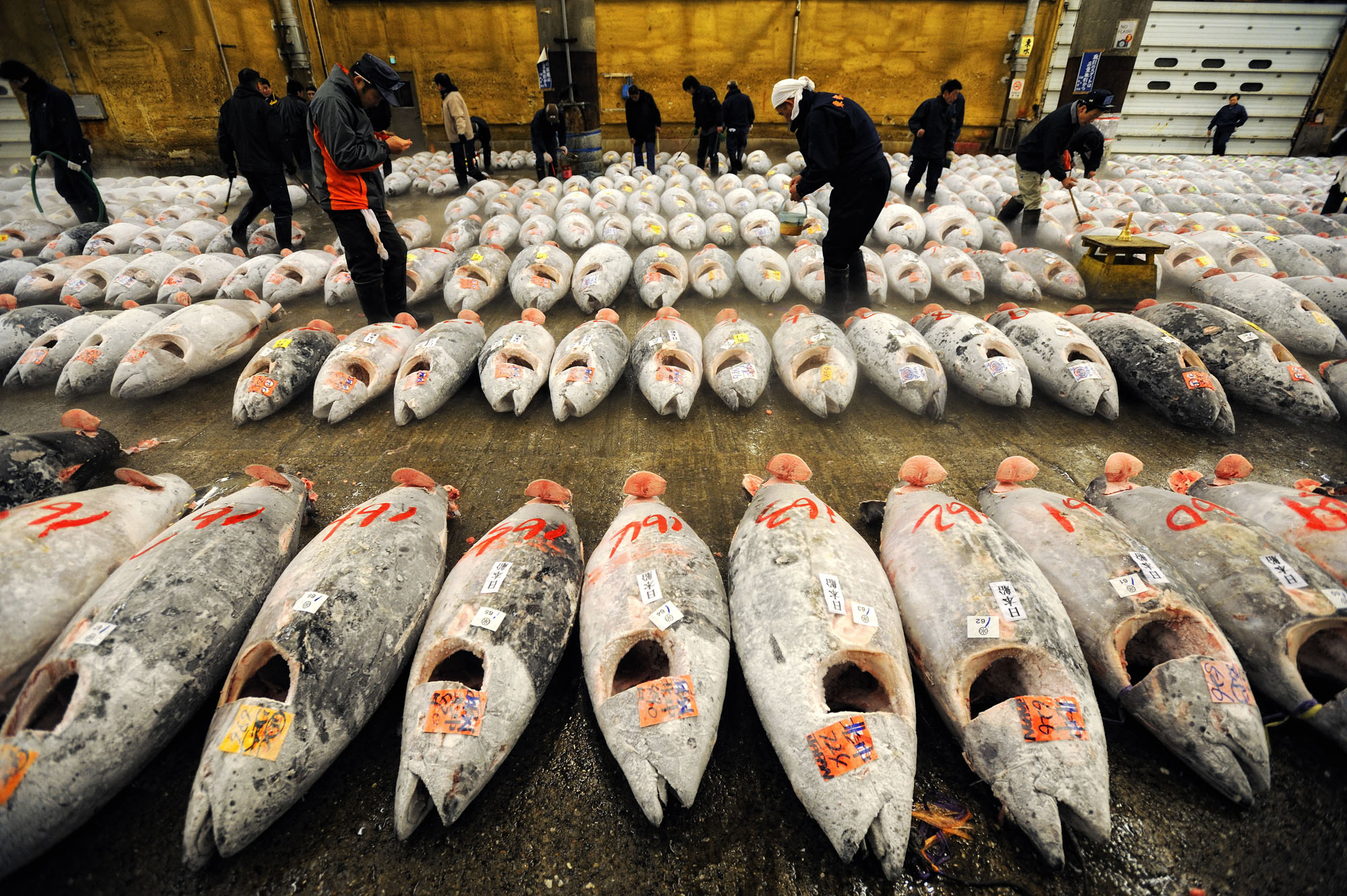
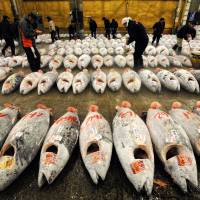
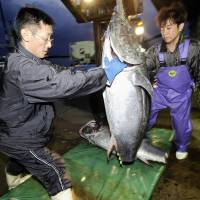
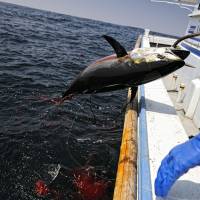
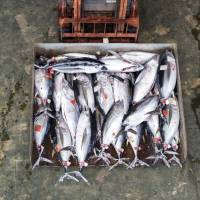

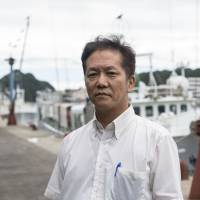
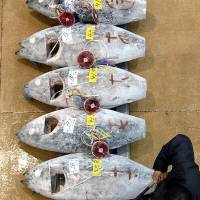
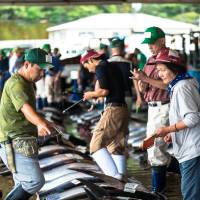














With your current subscription plan you can comment on stories. However, before writing your first comment, please create a display name in the Profile section of your subscriber account page.